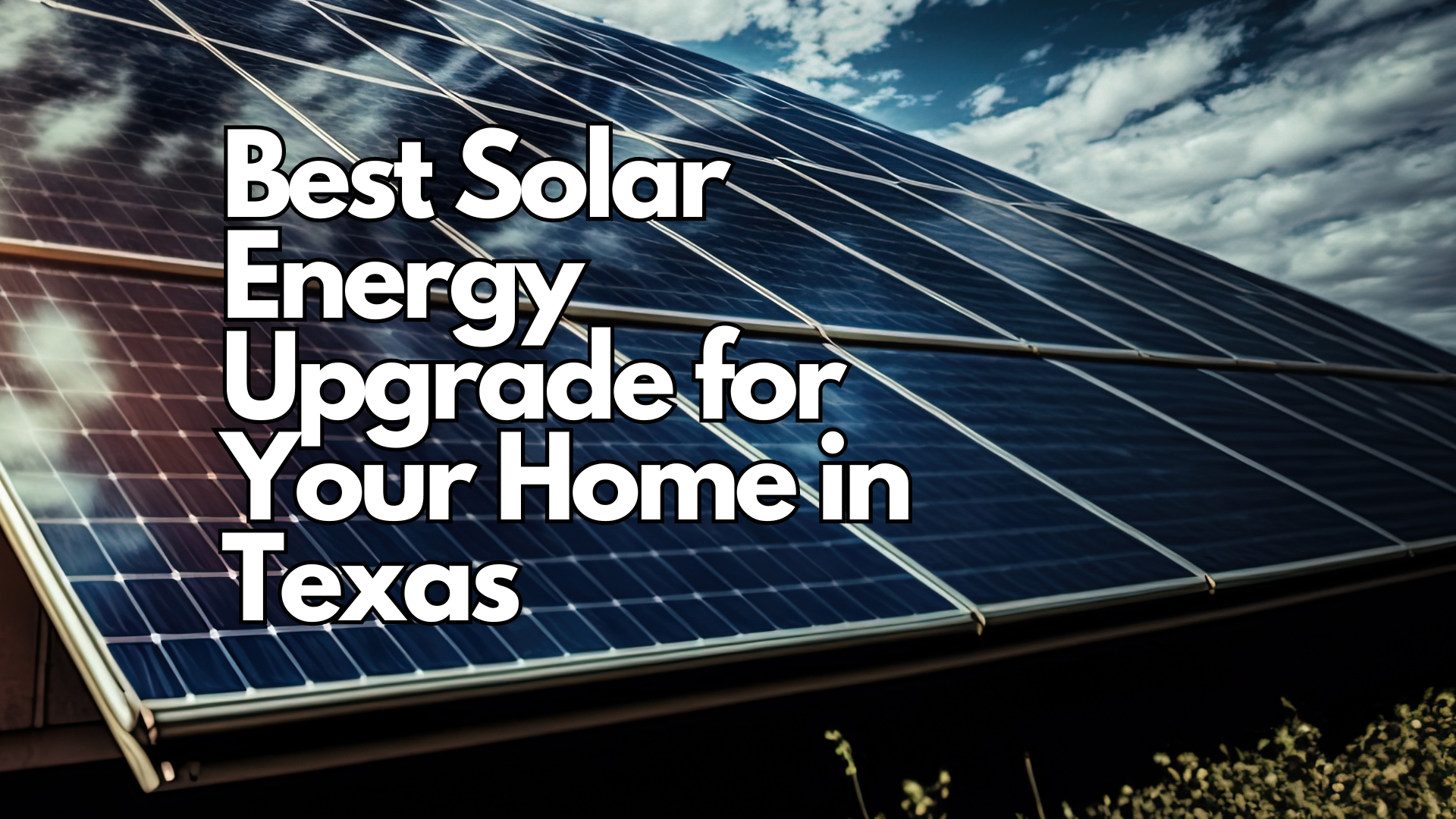Best Clean Energy Upgrade for Your Home in Texas

Are Solar Panels Good for your Home in Texas ?
Solar panels can provide significant benefits for homeowners in Texas. With abundant sunlight and supportive state policies, solar panels can be a viable and cost-effective solution for many Texans.
Texas is ranked among the best states for solar power due to its abundant sunlight, receiving an average of 234 sunny days per year, compared to the national average of 205. This makes Texas ideal for solar power generation, with photovoltaic panels being able to convert sunlight directly into electricity and with homes in Texas potentially being able to produce vast amounts of solar energy.
- Homeowners in Texas can benefit from the federal solar tax credit, which can reduce the cost of solar panel installation by 26% (Source: EnergySage).
- Solar panels can increase a home's resale value.
Buyers are willing to pay more for homes with solar photovoltaic (PV) energy systems — approximately $4 more per watt (Source: Department of Energy’s Lawrence Berkeley Laboratory).
The Benefits Of Solar Energy As a Home Owner In Texas:
1. Cost Savings:
2. Environmental Benefits:
3. Increased Property Value:
Understanding the benefits of solar energy in Texas is crucial for homeowners looking to invest in sustainable upgrades. Texas, known for its vast landscapes and abundant sunshine, offers an ideal environment for harnessing solar power. One of the most compelling advantages is the substantial reduction in electricity bills.
Given the state's high temperatures and extensive use of air conditioning, energy consumption spikes during summer months. As a homeowner in Texas, there are numerous benefits to harnessing solar energy. Here are three significant advantages:
1. Cost Savings:
- Reduced Electricity Bills: Once the solar panels are installed, they can significantly reduce or even eliminate your monthly electricity bills. Texas gets abundant sunlight, making solar energy a reliable source of power.
- Power Purchase Agreements (PPAs) and Net Metering: Texas utilities and electricity providers often offer incentives such as net metering, which allows you to sell excess electricity generated by your panels back to the grid, further offsetting costs.
- Tax Incentives and Rebates: Federal tax credits, like the Investment Tax Credit (ITC), provide substantial savings by assisting with the initial investment in solar panels. State and local incentives may also be available, enhancing overall affordability.
2. Environmental Benefits:
- Reduced Carbon Footprint: By switching to solar energy, you help reduce greenhouse gas emissions and reliance on fossil fuels. Solar power is a clean, renewable source of energy that contributes to a healthier environment.
- Energy Independence: Generating your own electricity means less dependence on the grid and non-renewable energy sources. This can help decrease the demand for energy from polluting sources like coal and natural gas.
- Sustainability: Adopting solar energy is a long-term commitment to sustainability. By investing in renewable energy, you're supporting the development and adoption of green technologies, contributing to a more sustainable future.
3. Increased Property Value:
- Higher Resale Value: Homes with solar panels are often more attractive to buyers. Studies have shown that properties equipped with solar energy systems can sell for a premium compared to those without.
- Market Appeal: As awareness of environmental issues grows, more homebuyers are seeking eco-friendly features. Solar panels can make your home stand out in the market, potentially leading to a quicker sale.
- Energy Efficiency: A solar-powered home is perceived as more energy-efficient, which is a desirable quality for many buyers. This can translate into a competitive edge in the real estate market.
Navigating Texas Solar Incentives And Rebates:
The Lone Star State offers a variety of programs aimed at reducing the initial costs and expediting the return on investment for homeowners considering solar energy installations.
One of the most notable incentives is the federal Solar Investment Tax Credit (ITC), which allows homeowners to deduct a significant percentage of their solar installation costs from their federal taxes.
Moreover, Texas offers various incentives to encourage solar adoption. Federal tax credits can cover up to 30% of installation costs, while state policies often include additional rebates and net metering programs that allow homeowners to sell excess energy back to the grid. This combination of financial benefits can make the initial investment more manageable.
Installing Solar for Optimal Energy Storage In Texas
Solar panels transform the Sun's light into electricity through a process called the photovoltaic effect. The structure of a solar panel consists of numerous tiny cells made from semiconductor materials, typically silicon.
These cells are coated with a material that enhances light absorption called an antireflective coating, and they're surrounded by a conductive metal plate. When sunlight strikes these coated cells, it stimulates the movement of free-flowing electrons within the semiconductors, generating an electric current known as direct current (DC).
The DC electricity is then converted into alternating current (AC) electricity, which is the type of power most commonly used in households. This conversion is done by a device called an inverter. The source of solar energy is the Sun, making it a renewable, carbon-free, and cost-effective type of power.
As far as setting up solar panels on your roof goes:
1. Get a Professional Assessment: The first step is to get a professional solar installer to conduct a site assessment. They will examine your roof's slope, shading, orientation, and structural soundness to calculate the best configuration for the panels.
2. Installation: Once you've decided on the best setup, the solar company will install the panels on your roof. This process involves securing panels in place with the help of mounting systems and making sure they are adequately tilted towards the sun to absorb maximum sunlight.
3. Connect to the Grid: After installation, local utility companies generally do an inspection before connecting your house to the grid. The utility company usually installs a new meter capable of moving backwards when you generate extra electricity.
4. Battery Setup (Optional): For houses in areas with grid instabilities or high blackouts, a solar battery could be installed as well to store excess energy produced by your system.
5. Monitoring: Most solar companies provide a monitoring system so you can keep track of how much electricity your panels are generating and how much you're saving.
Installing solar batteries for energy storage is a transformative step in maximizing the efficiency and reliability of your home’s clean energy system. Solar batteries work by capturing surplus electricity generated by your solar panels during peak sunlight hours and storing it for later use.
Integrating Smart Home Technology With Solar Systems
Battery storage solutions further enhance this integration by storing excess solar power generated during sunny periods for use during nighttime or cloudy days. Smart home technologies ensure seamless transitions between stored energy and grid power, maintaining a consistent energy supply without manual intervention.
This synergy creates an eco-friendly lifestyle that aligns perfectly with the growing emphasis on environmental responsibility in the Lone Star State.
Maintenance And Longevity Of Your Solar Energy System
Ensuring the longevity and optimal performance of your solar energy system in Texas involves regular maintenance and a few key considerations. Solar panels are designed to withstand various weather conditions, but the intense Texas sun, occasional hailstorms, and dust can impact their efficiency over time.
Regular cleaning is crucial; dust, pollen, and bird droppings can accumulate on the panels, reducing their ability to absorb sunlight efficiently.
A simple rinse with water or a gentle scrub with a non-abrasive brush can keep them clean.
Periodic inspections by professional technicians are essential. They can identify potential issues such as loose connections, corrosion, or damage from extreme weather events before they escalate into significant problems.
Waterline, the new supertall tower in Austin. pic.twitter.com/96HW0br6VM
— Citycast™ (@metroTM32) September 8, 2023
Nice view of the north end of Rainey featuring the U/C 1,022' Waterline, 658' Modern Austin & 594' Travis towers. Credit: SproutingTowers at skyscraperpage. pic.twitter.com/rflmMHwJ6m
— The ATX (@TheATX1) March 12, 2024
Go green ~ another scam #Texas Destroying solar energy pic.twitter.com/wcrbiVG463
— Krissy (@bornagain33333) March 27, 2024
















